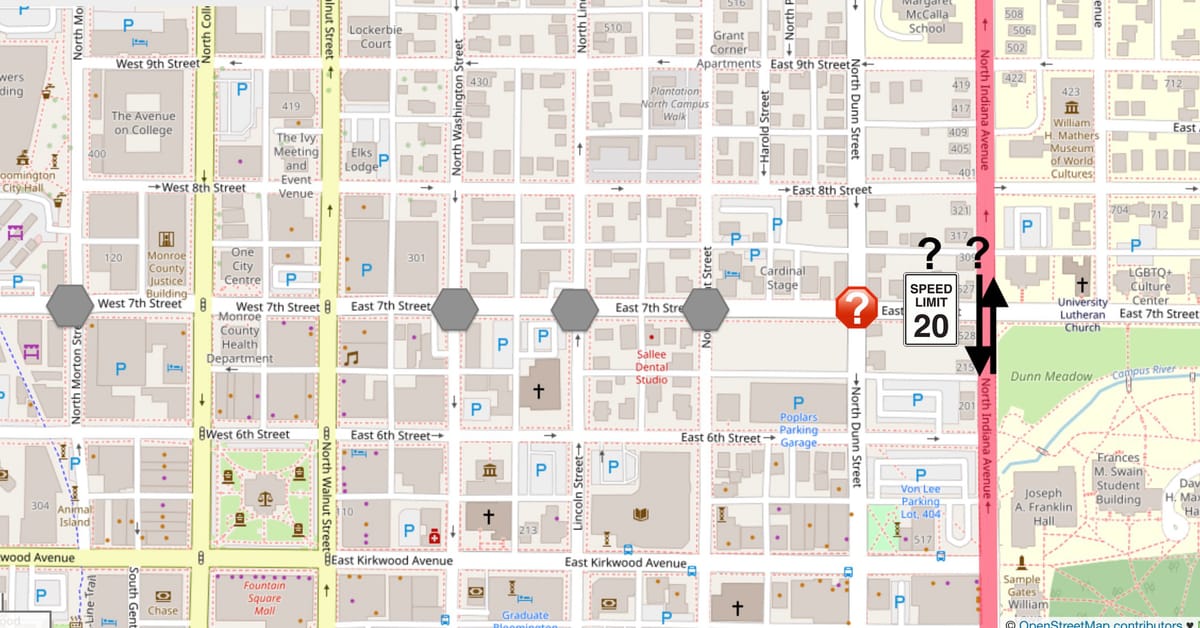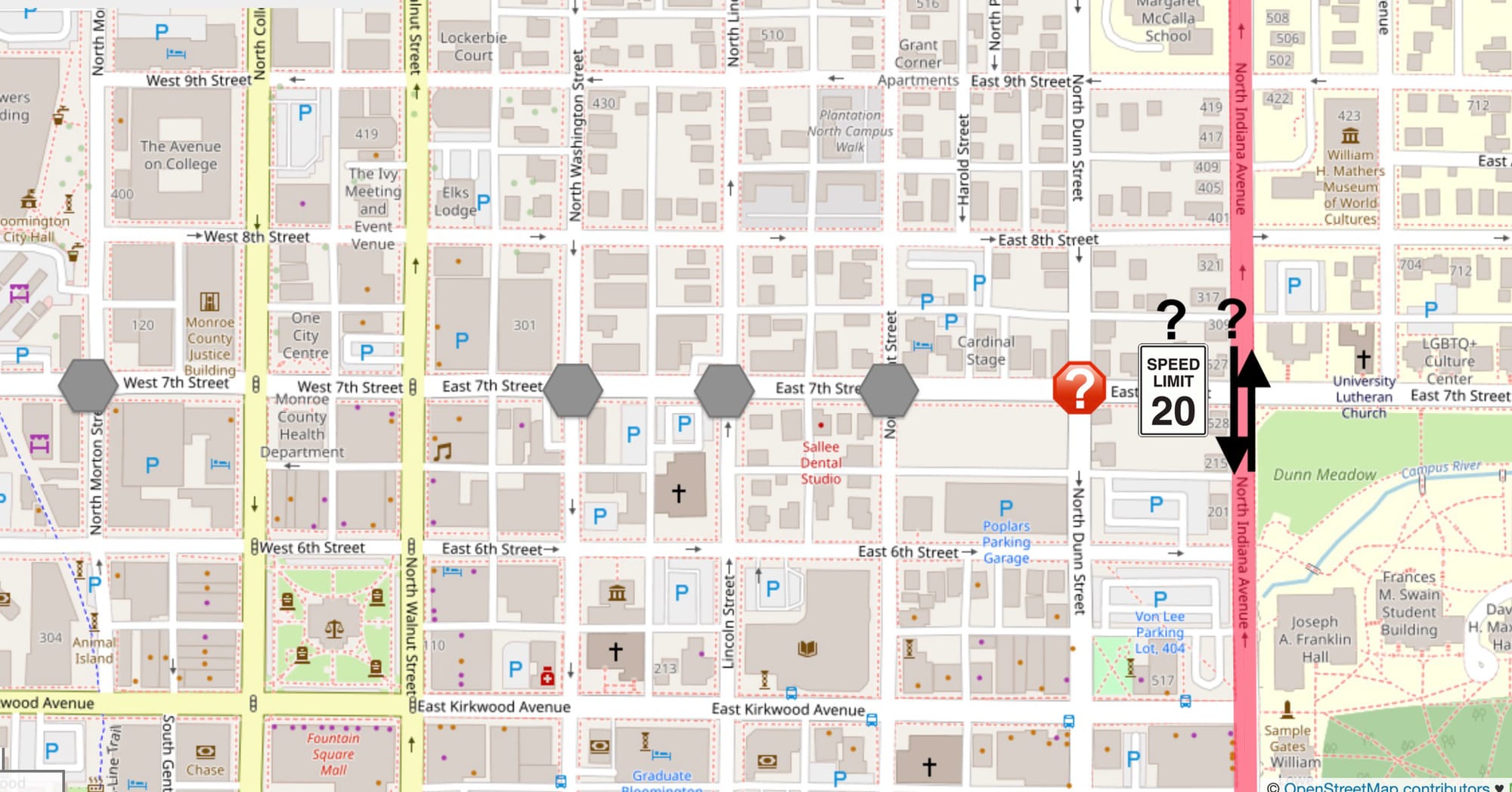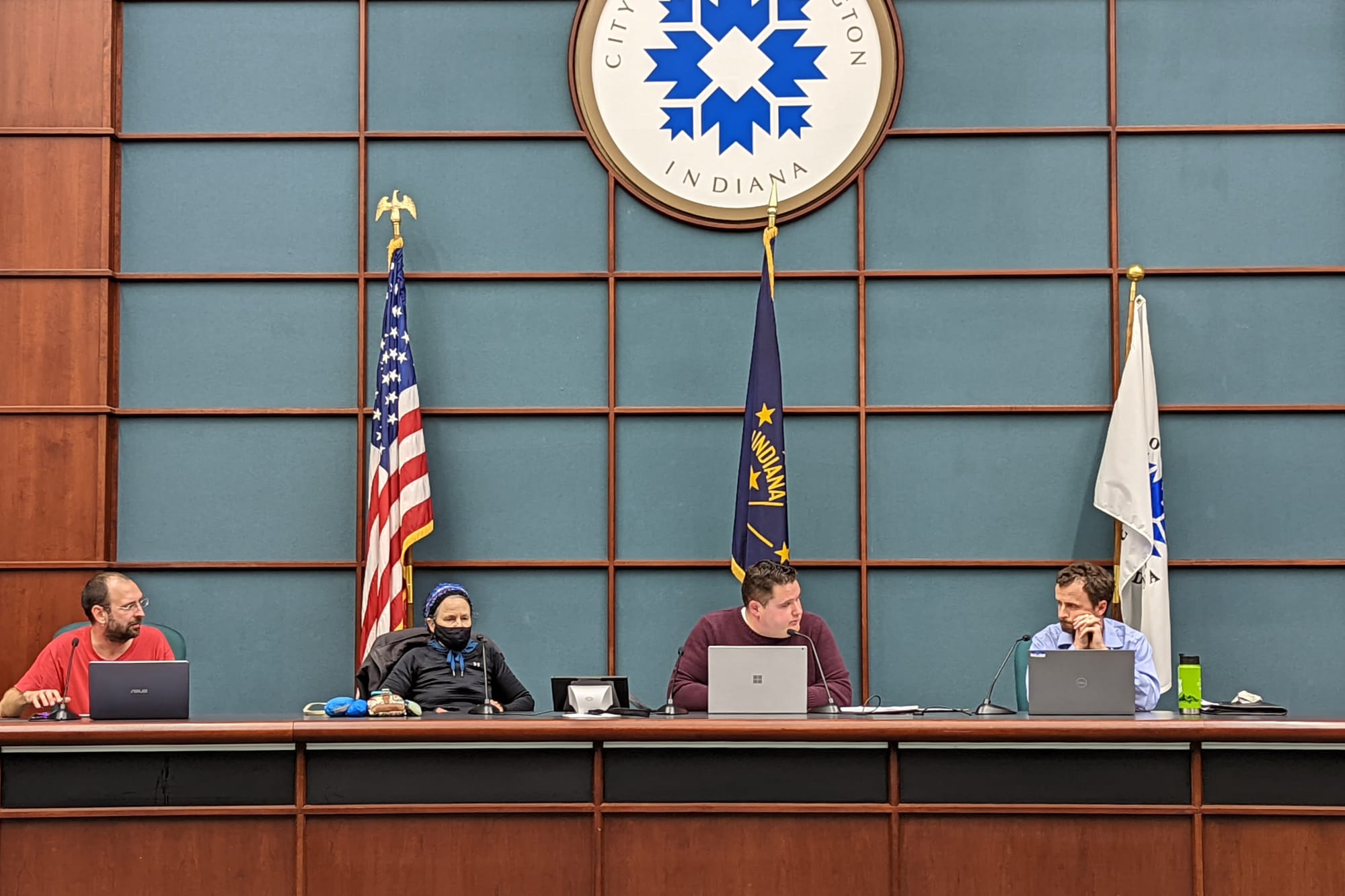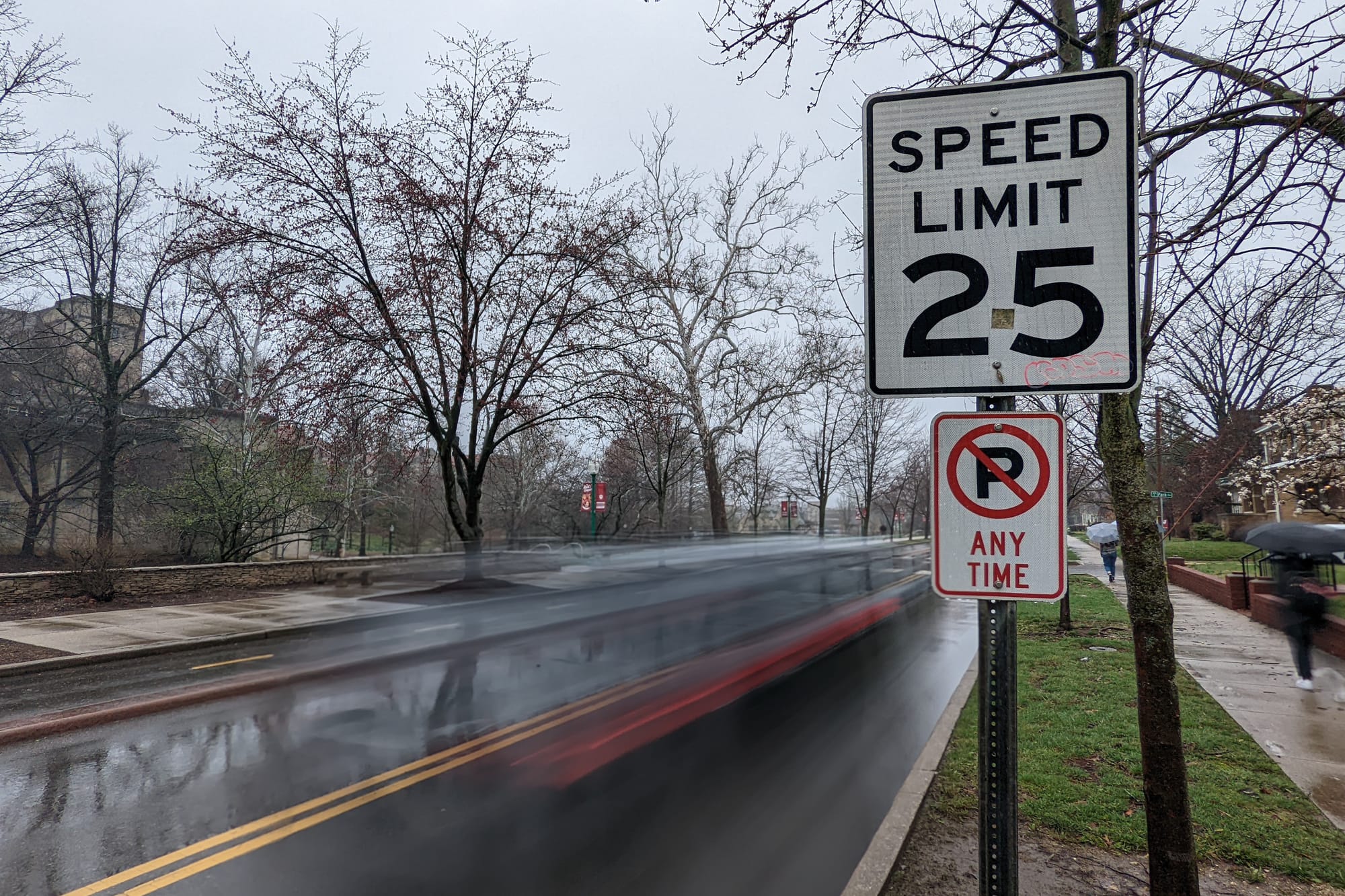Traffic commission agrees with bike/ped group on 7th Street: Reinstall stop sign only at Dunn




A recommendation from city engineer Andrew Cibor, to reinstall five stop signs along 7th Street in downtown Bloomington, will not have complete support from two advisory groups when it lands in front of the city council.
On Monday, the bicycle and pedestrian safety commission (BPSC) recommended reinstalling just one of the five stop signs, which were removed in connection with the construction of the 7-Line separated bicycle lane under an ordinance enacted by the city council.
On Wednesday, the traffic commission followed suit, unanimously recommending that the intersection at 7th and Dunn street be restored to an all-way stop.
It’s not clear when the recommendation will be put in front of the city council for a vote.
The impetus behind Cibor’s recommendation to reinstall the stop signs is an increase in crashes at the intersections after the 7-Line was opened in late 2021.
Both appointed groups explicitly rejected Cibor’s recommendation that stops for 7th Street traffic at Morton, Lincoln, Washington, and Grant streets also be reinstalled.
The vote against reinstallation of the other four stop signs was unanimous on the BPSC. But traffic commissioners were split 4–2.
Cibor is a member of the city’s traffic commission and voted to support his own recommendation. The other vote for reinstallation came from Bloomington police officer and traffic commissioner Benjamin Burns.
Cibor’s report to the traffic commission about the 7-Line indicated that the 7th Street corridor showed an increase from 6.25 crashes per quarter to 10.25 crashes per quarter.
When the crashes are broken down by intersection, 7th Street at both Washington and Lincoln had 5 crashes in the last year. And 7th Street at Dunn had 12 crashes.
The guidance in the MUTCD (Manual on Uniform Traffic Control Devices) says that in order to add stop signs to create an all-way stop, an intersection should meet one of several criteria. One of the criteria is 5 or more reported crashes in a 12-month period that are susceptible to correction by a multi-way stop.
Cibor’s recommendation to reinstall the stop signs at all five intersections is based on the fact that three out of the five intersections meet the criterion for number of crashes. Cibor said the other two intersections were trending upward, even if they had not hit five crashes.
At this week’s BPSC meeting, commentary against reinstallation of all five stops came from cyclists who reported that they have started using the 7-Line precisely because 7th Street traffic was not required to stop. At Morton Street, in the uphill (east) direction, a stop sign would mean loss of momentum that is useful for pedaling up the hill.
Cibor’s report to BPSC and the traffic commission noted that in some of the police reports for the crashes, motorists who were approaching 7th Street on a north-south side street told the responding officer they thought it was an all-way stop.
Getting better compliance by north-south drivers is one part of the challenge, Cibor said. But the other contributing factor to crashes is that 7th Street drivers are going too fast for them to accommodate a north-south driver’s mistake.
The speed limit for that part of 7th Street is 25 mph. But the average speed recorded in Cibor’s report is 27 mph with an 85th percentile at around 32 mph.
In the state of Indiana, urban roadways like 7th Street by default have a speed limit of 30 mph, but cities can impose a lower speed limit of 25 mph.
Based on B Square inspection, in the westbound direction along the 7-Line corridor, the only place where a 25 mph speed-limit sign is posted is just after the turn onto 7th from Woodlawn. The B Square could not identify any 25 mph speed-limit signs in the eastbound direction.
Traffic commissioner Greg Alexander talked about the relationship between enforcement of speed limits and the engineered design of the 7-Line, which has a two-way bicycle lane on the south side of the roadway, separated from car traffic by medians. “Now we’ve got a good design,” Alexander said. He added, “And I think it would only take a little coercion to get drivers to accept going slower here.”
Alexander asked Cibor: “Have we tried enforcement? Have you had any conversations or cooperation with BPD?”
Cibor said that there are limited tools available for enforcement—automated ticketing for speeding is off the table in the state of Indiana. Bloomington’s police department is currently staffed at levels way under what the budget calls for, which is part of an ongoing recruitment and retention challenge.
Alexander wanted to know Cibor’s opinion about possibly reducing the speed limit on 7th Street to 20 mph. Cibor didn’t sound sanguine about the idea of just looking at 7th Street for that kind of change. He recommended a more comprehensive approach to the 20 mph question.
Cibor said when the 7-Line was being designed, city staff hoped that the measured speeds would be closer to 20 mph. Cibor said it would be worth looking at 4th Street, Kirkwood Avenue, and 6th Street, and other other streets in the immediate downtown area, to consider lowering the speed limit to 20 mph.
“I’m not necessarily opposed or in favor, but I think that that is a good question that probably warrants additional and probably its own focused conversation,” Cibor said.
Responding to a question from the B Square from the public mic, Cibor said the report he’d given on the 7-Line was not the statutorily required “engineering and traffic investigation” that would be required to lower the speed limit on 7th Street from 25 mph to 20 mph.
Ryne Shadday, who is president of the traffic commission, said that it’s motorists who need to look out for bicycles and pedestrians. “As motorists, we are driving one- to six-ton vehicles or more, on the streets.” He continued, “We have the responsibility of paying attention to who we might kill.”
He added, “At the end of the day, the motorists are driving the killing machine, right?” Shadday asked, “So why are we still putting the onus on the bicyclists and the pedestrians to stop, when the motorists are the ones who need to be paying attention here?”
In his final comments, Alexander advocated for slower speeds on 7th Street. “The design can work,” he said, “but not if it’s impossible to get drivers to slow down.”
Alexander said that given a choice, drivers would prefer to drive only 20 mph if that means they don’t have to stop every block. About the speed, Alexander said, “I think we need to reduce the speed limit to 20. And we need to have enforcement—we cannot simply concede the speed battle.”
Alexander also suggested that Indiana Avenue be made into a two-way street—it’s currently one-way north. The reason Dunn Street carries as many cars as it does, Alexander said, is that many of Dunn Street’s southbound motorists would prefer to be driving south on Indiana Avenue.
Wednesday’s traffic commission meeting was the first one of the year. It was also the first meeting since calls were made for Alexander’s removal from the commission, based on Tweets he posted last year, in connection with a stop sign installation at Maxwell Lane and Sheridan Drive in the Elm Heights neighborhood.
City councilmembers Susan Sandberg, Dave Rollo, and Ron Smith have indicated that they want to remove Alexander from the commission for Tweets that were crude (“haters gonna hate and bloomington democrats gonna lick the shit out from between elm heights’ neighbors ass cheeks.”) or made them feel threatened (“what are they punching through with? i would really like to know. it sounds like they are going to savagely penetrate your neighborhood and i want to know what they’re going to use to do that?”).
Two motions on Alexander’s removal have been made at previous meetings, but withdrawn. It’s still possible that another motion on his removal could be made at the city council’s next meeting on March 29.
At the start of Wednesday’s traffic commission meeting, vice president Sarah Ryterband commented on the city council’s possible action to remove Alexander.
Ryterband said, “I just wanted to express my deep disappointment that a common council member would malign a member of the traffic commission, who is doing an exemplary job as a traffic commissioner.” She continued, “I want Mr. Alexander to know that he has my absolute support.”
Ryterband added, “I am disappointed in his use of social media to express his personal opinions—not as a member of the traffic commission but as a person.”
About social media in general, Ryterband said, “For those who choose to go to social media as a way of communicating one to another, if you’re going to wade into a cesspool, you can expect to be dirty, and to find a lot of filth.”
She concluded, “So I would suggest that that’s not the best way to communicate with other humans.”




Comments ()